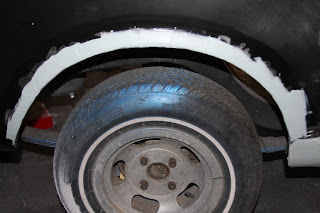
Often Matt and I discuss which part of the project we least like to do. Drilling out factory spot welds and removing old seam sealer are 2 of our least favorites. Ranking up there with those is block sanding body filler. It's a nasty messy job! Looking forward to getting this part finished so we can clean up the shop. Dust is on everything! We don't have too much more of it to do and will be ready for a coat of primer.
Today we worked on the passenger side quarter panel seams. We welded in a new quarter panel on both sides, and the weld seams were ground down and we are skim coating them with body filler.
Click Images to Enlarge
Here are a couple of pics from a previous blog update showing the weld seams we are applying body filler to. These old pics are from the drivers side, and we worked on the passenger side, but you get the idea!


Here is Matt prepping the area with the DA sander for a final skim coat of filler.

We are using Evercoats Rage Extreme plastic body filler. If you haven't tried it, you should. This stuff finishes off so smooth there is no longer a need to finish your repairs with polyester glazing putty.

Mixing the filler and hardner is not an exact science. The amount of hardner to filler is primarily determined by the weather. Cooler weather requires a little more hardner or you will be waiting a while to be able to sand it. The next couple of pics are Matt and I mixing up a batch of filler.

Normally a thin line of hardner across the filler is enough, but added a little more to help with the cold weather.

Mixing / blending

Applying Filler to the weld seam where the quarter panel meets the rocker. From the factory there is a 90 degree flange that is spot welded to the horizontal surface of the rocker from inside the car. We elected to butt weld, and fill over it to shave the seam. Fitting the theme of a few other things we have shaved on the car.

I mean, got to get in there close and hold your mouth just right!

We use Durablocks for block sanding.

The quarter panel did not fit very well where it welds to the inner wheel well, and we ended up with some slight imperfections in the metal around the opening so we did a skim coat of body filler

Doing a little block sanding...

You can see the high and low spots being revealed and filled.

And here is the butt weld seam with a skim coat of filler.






































